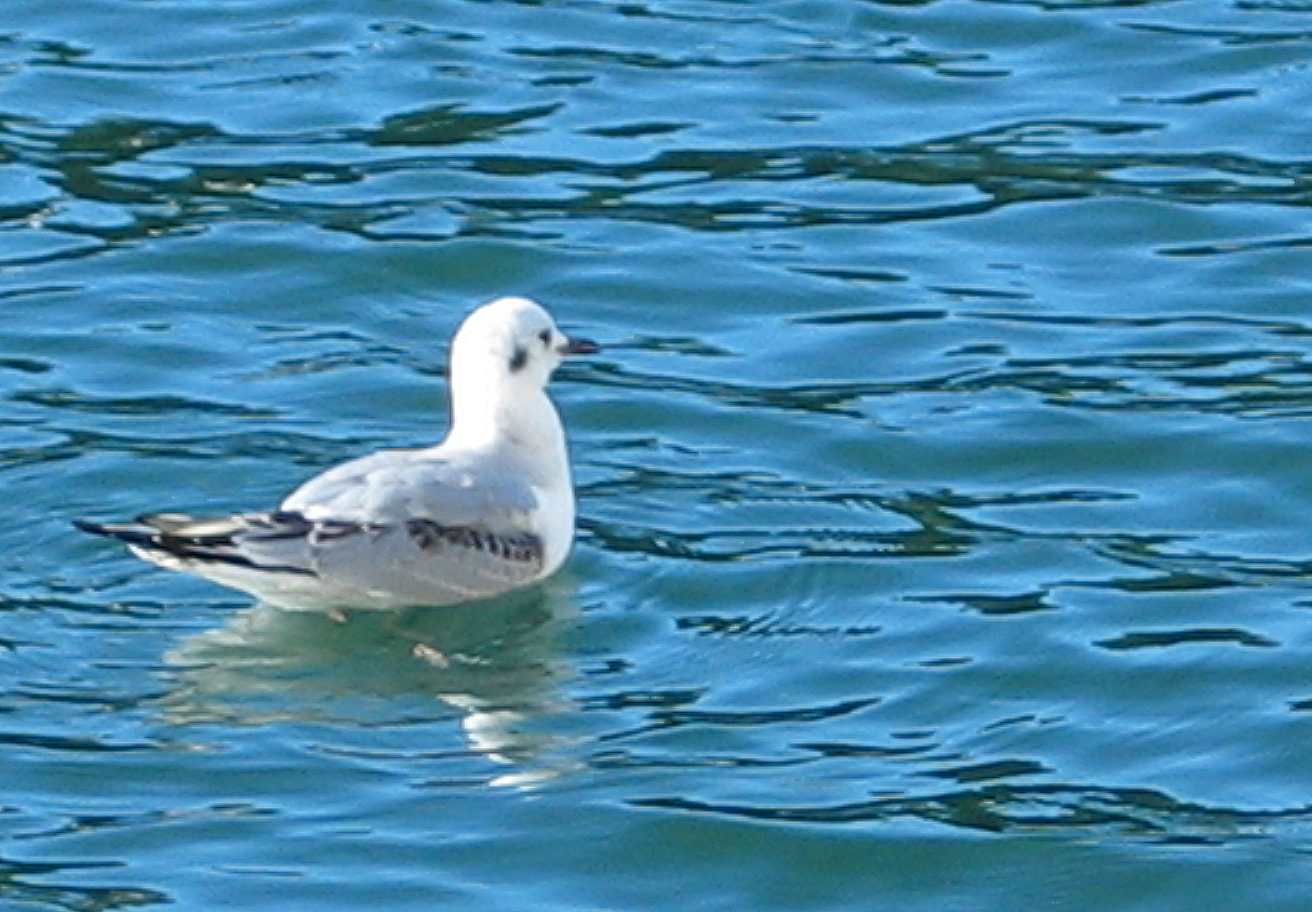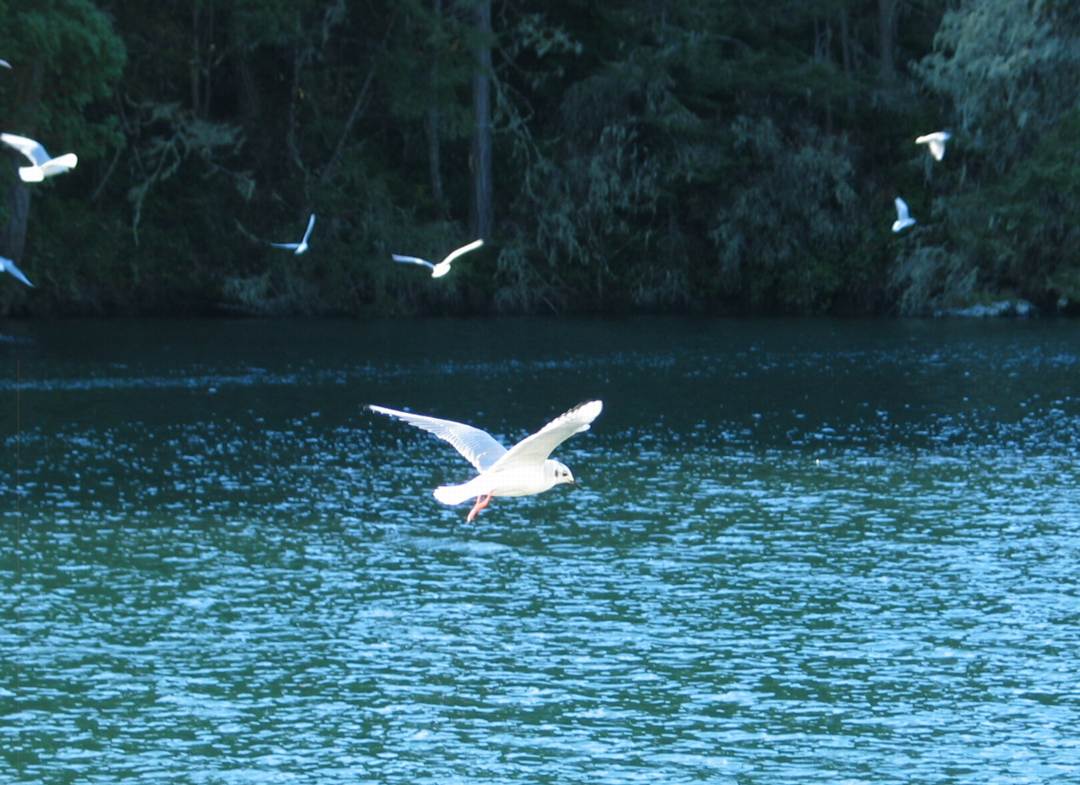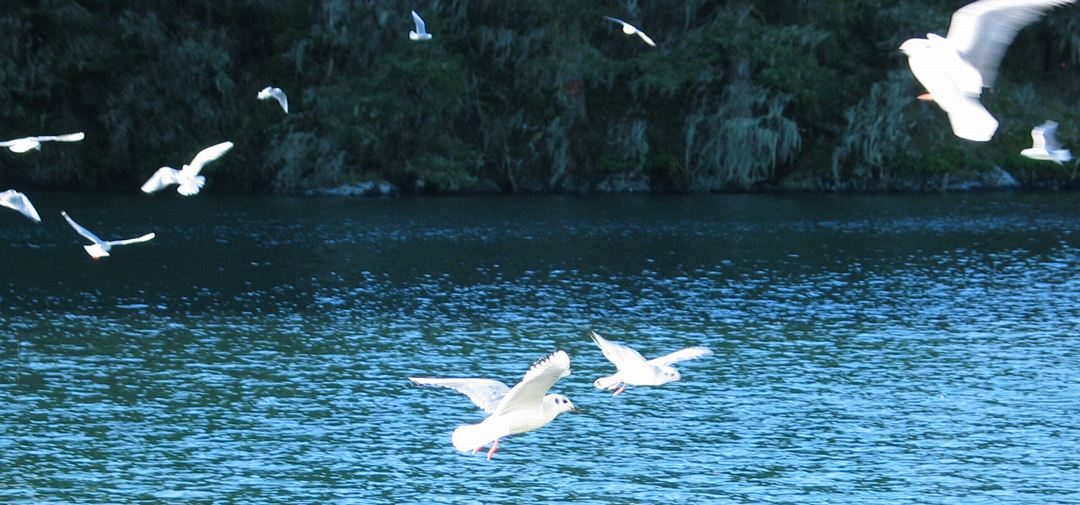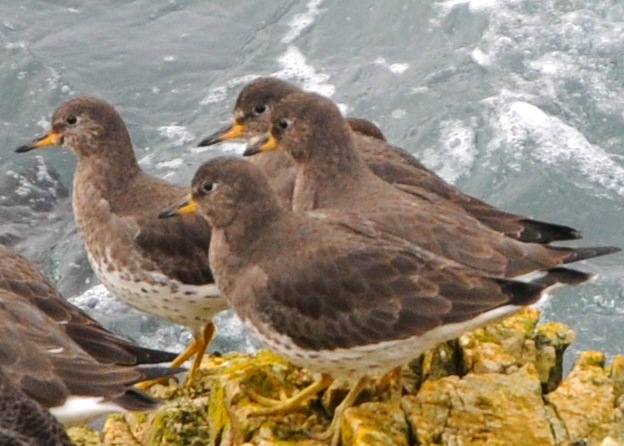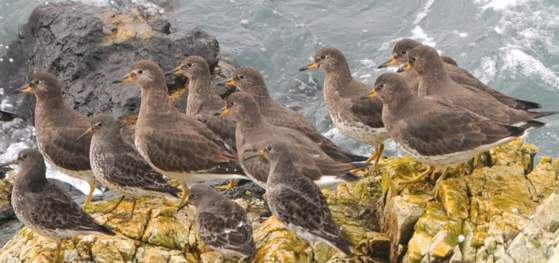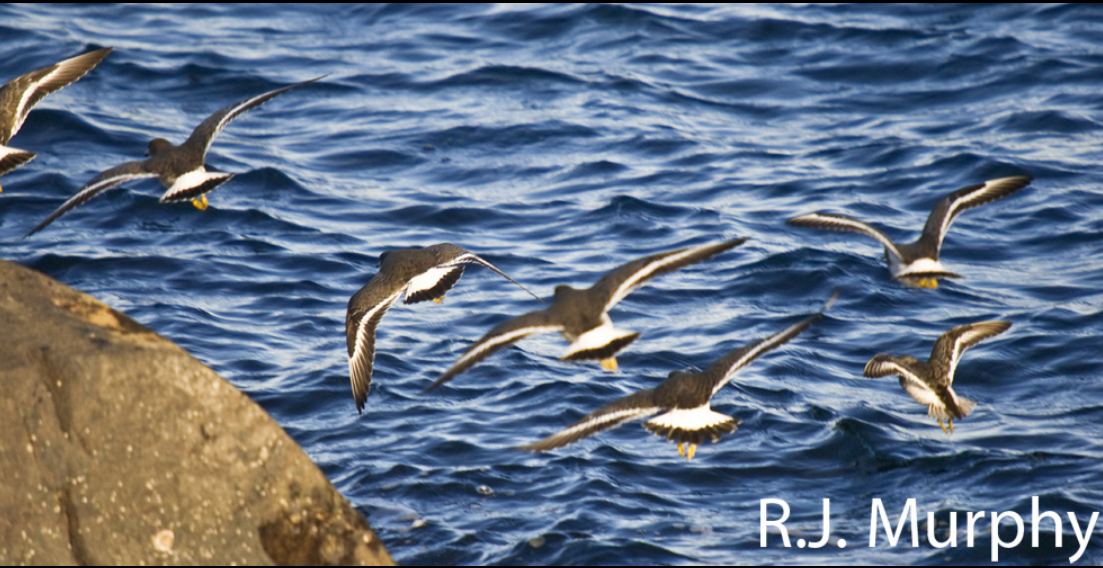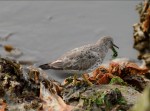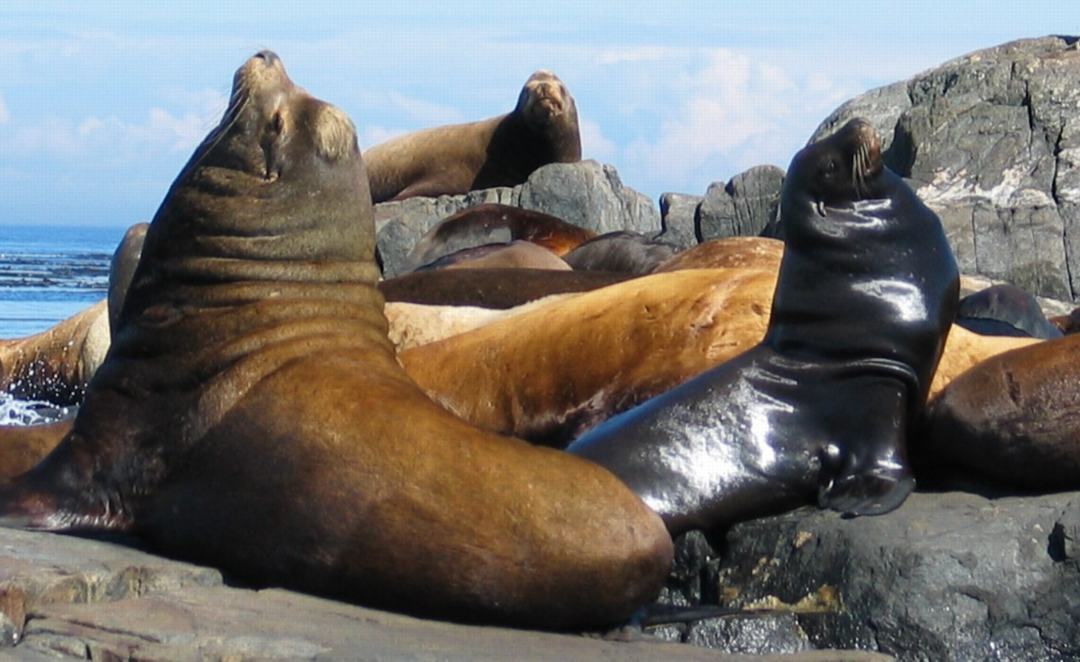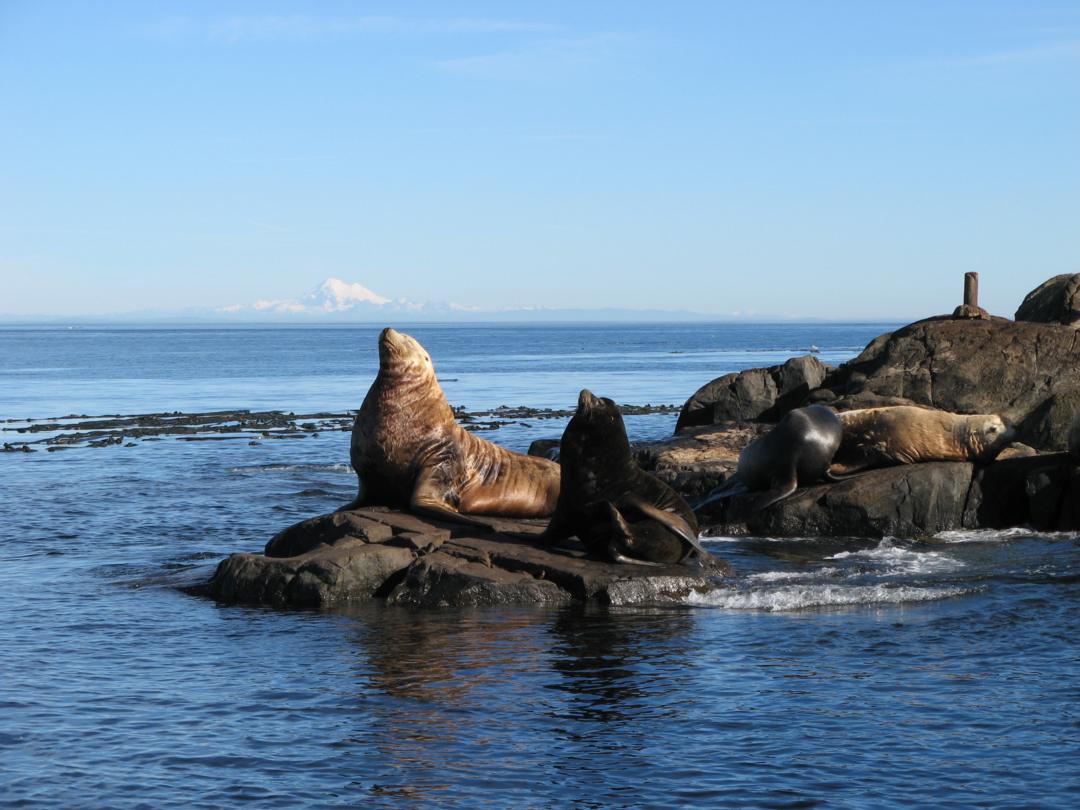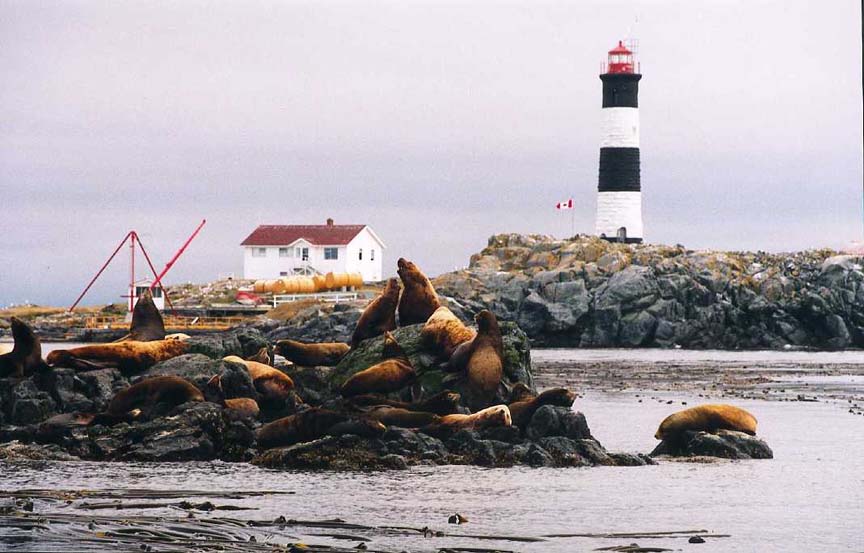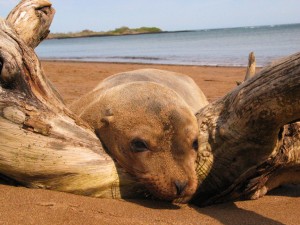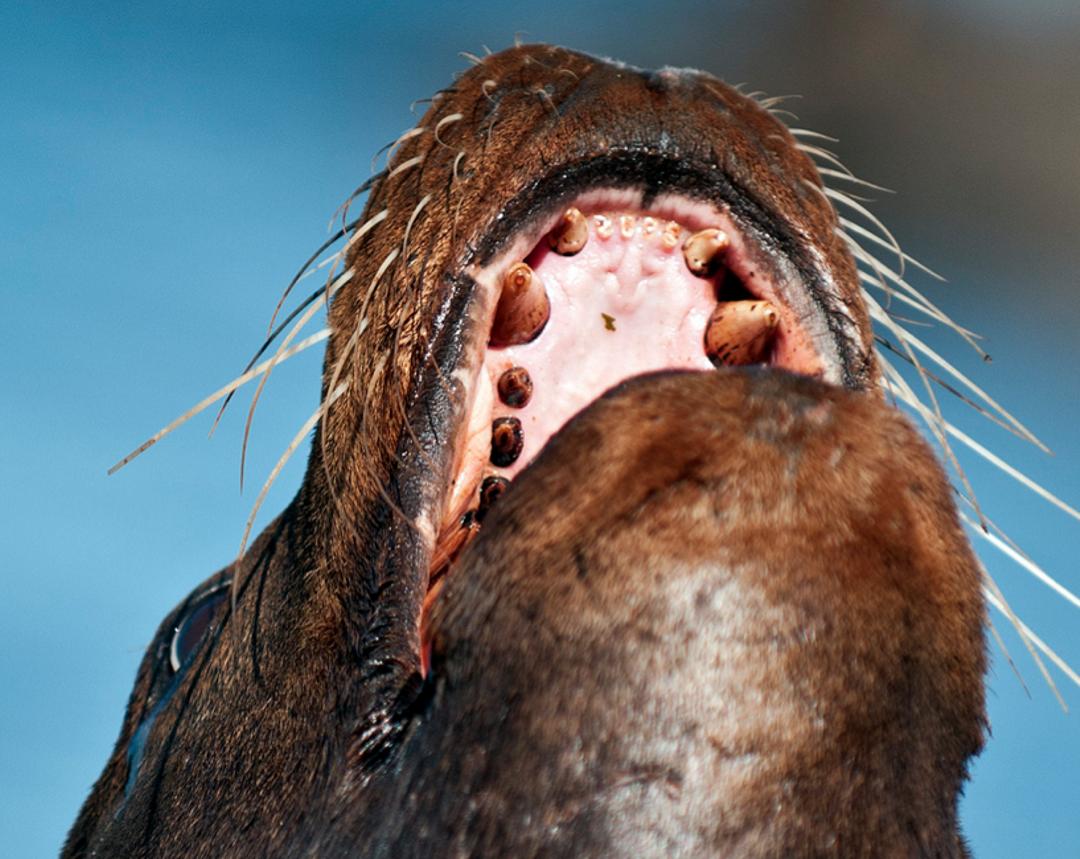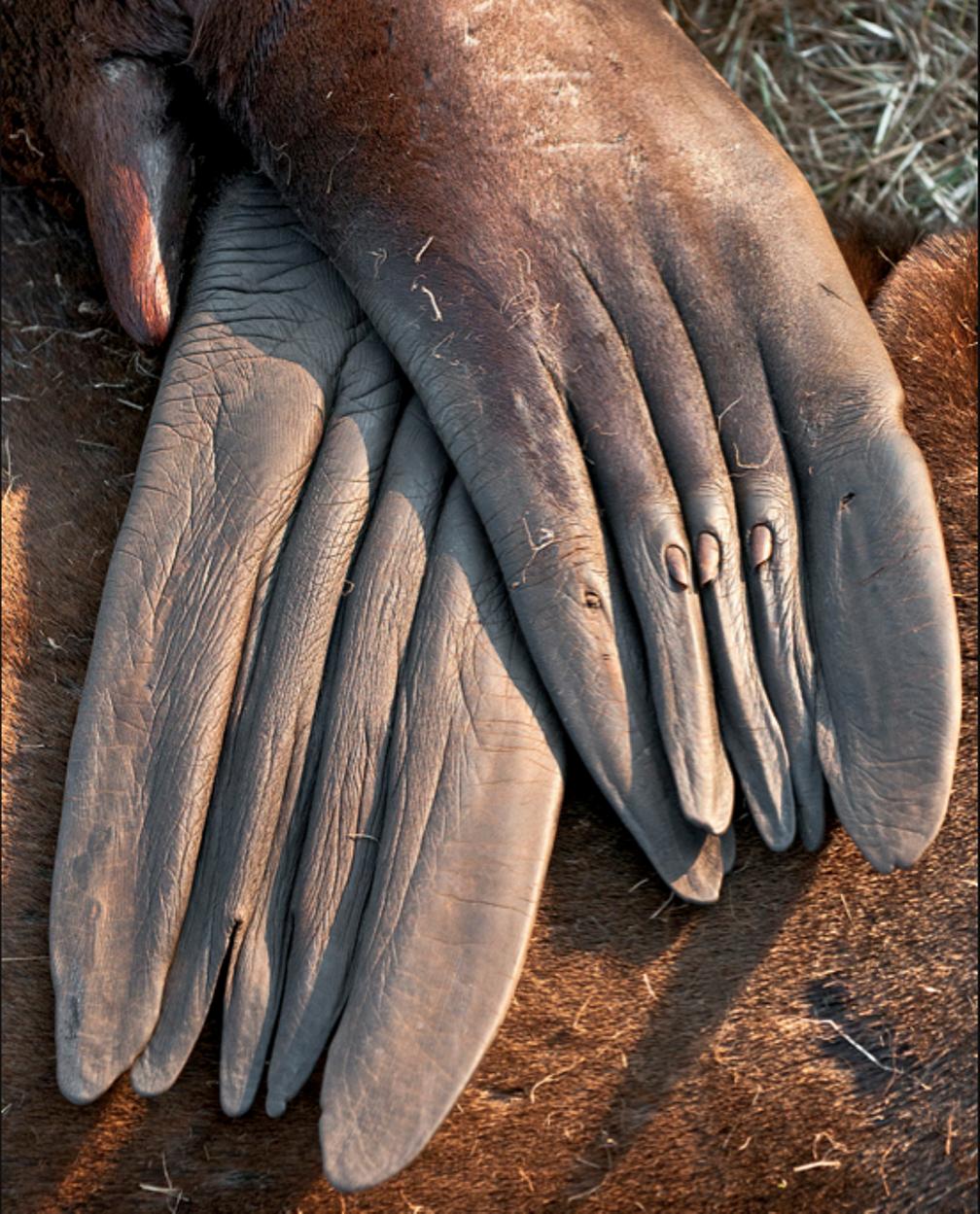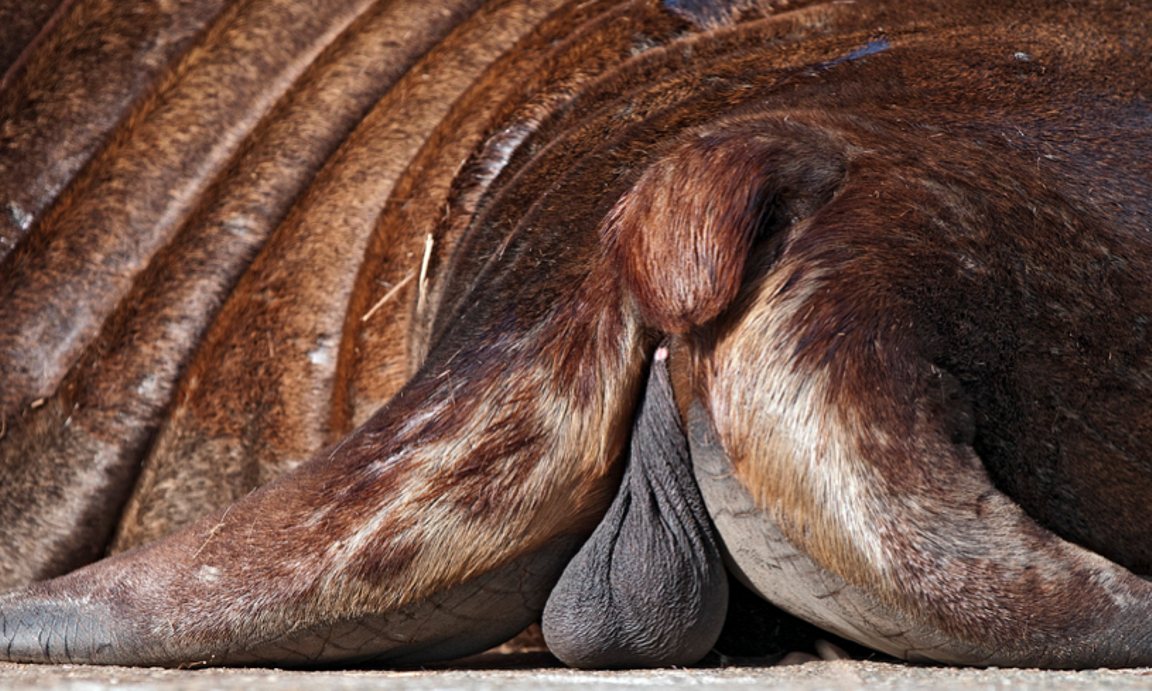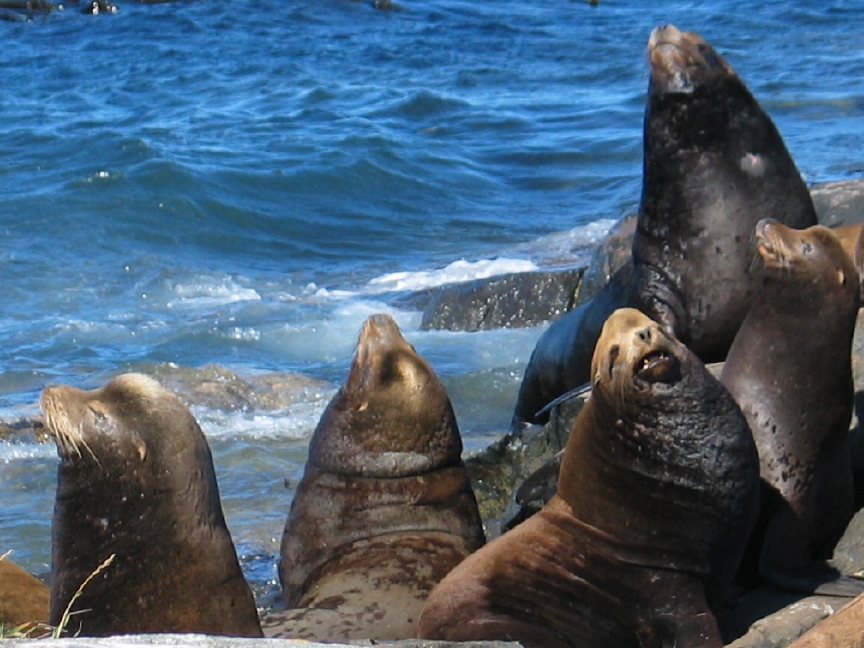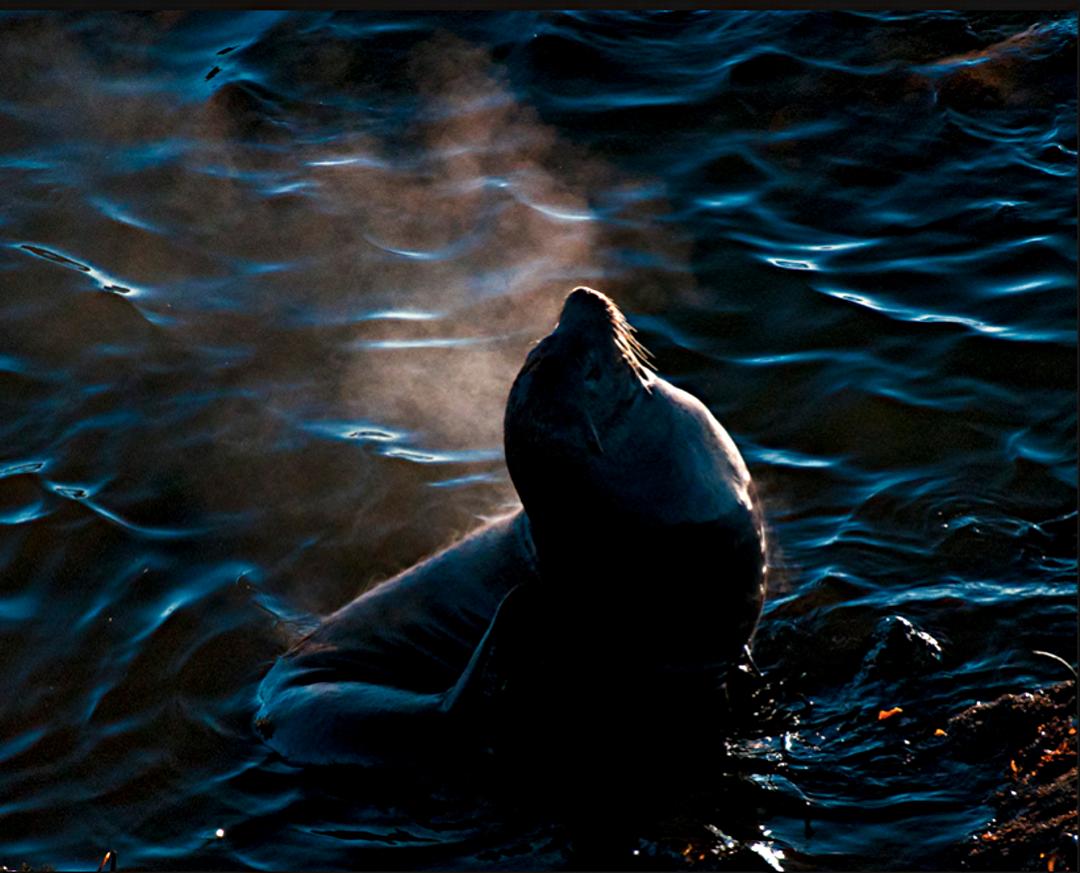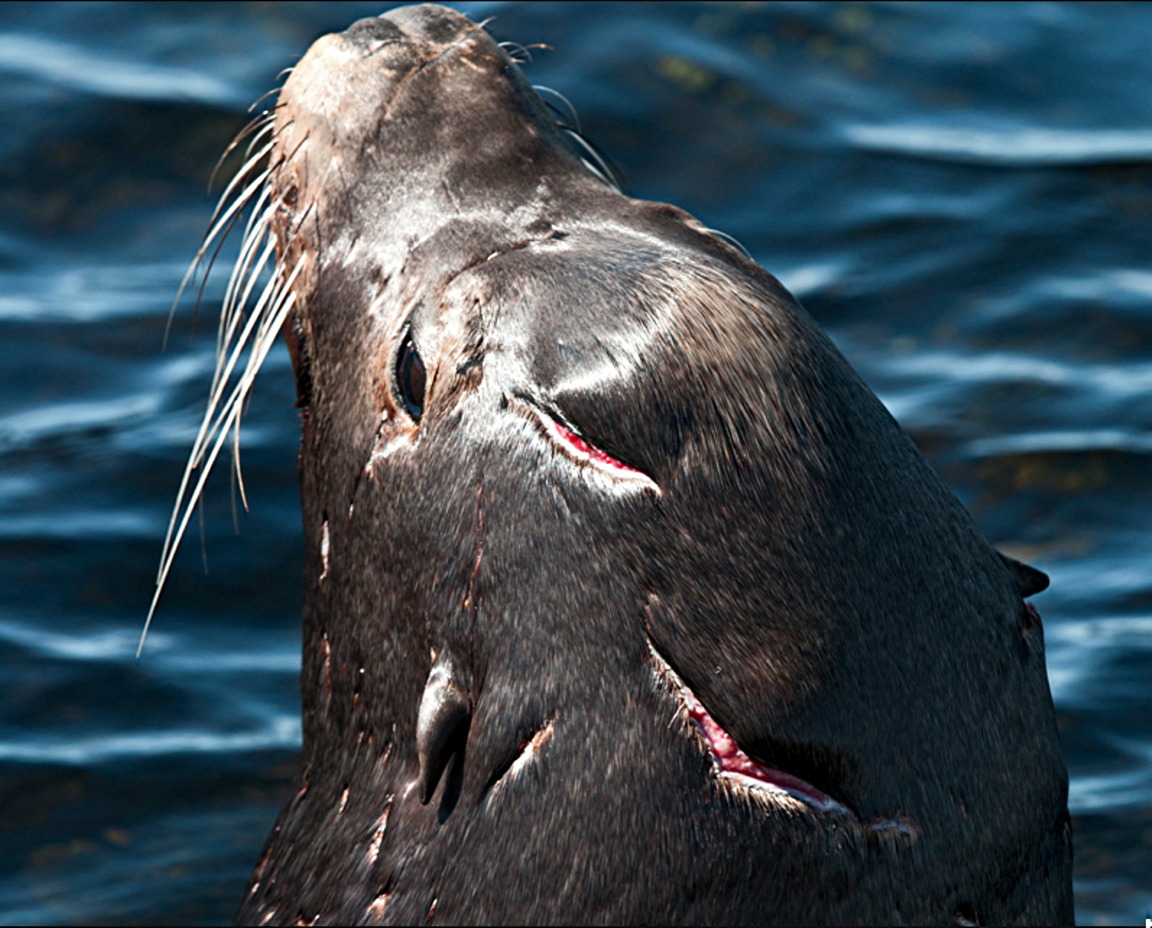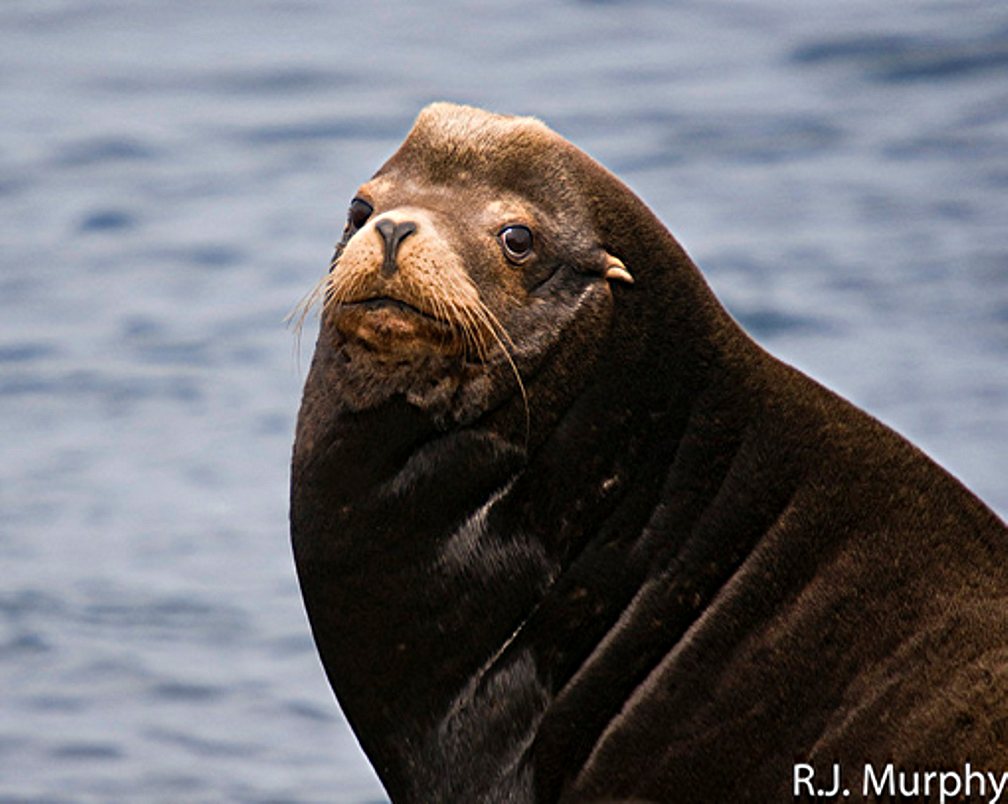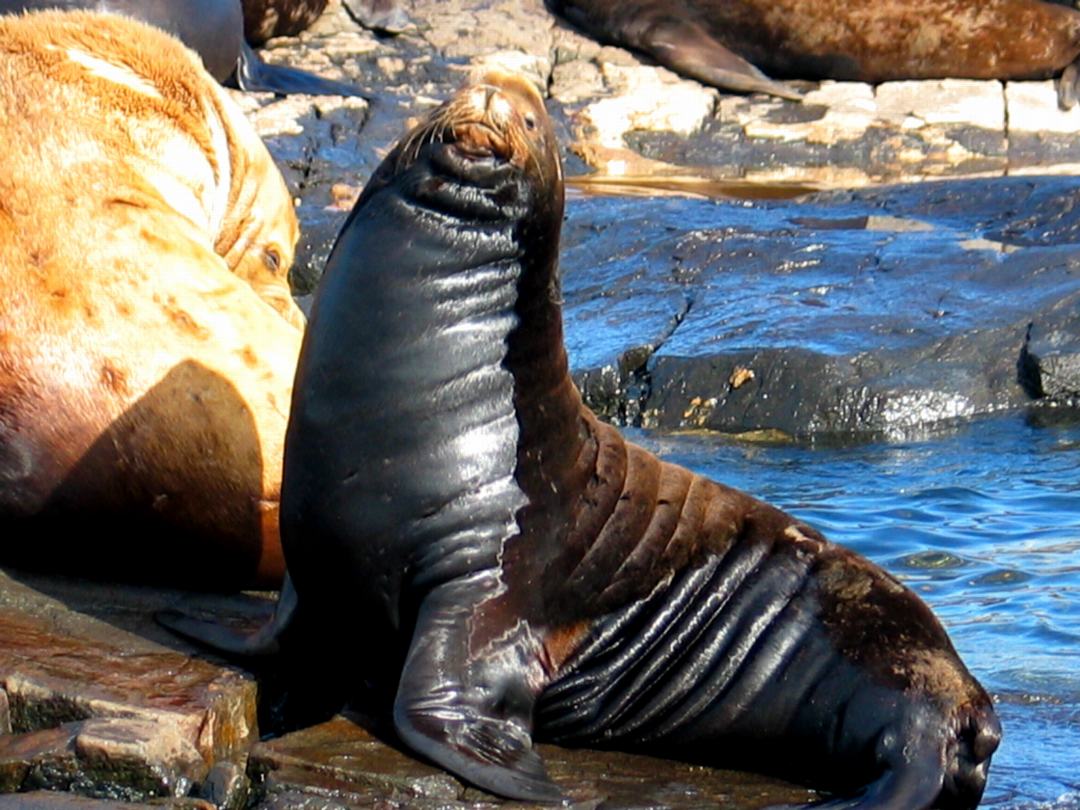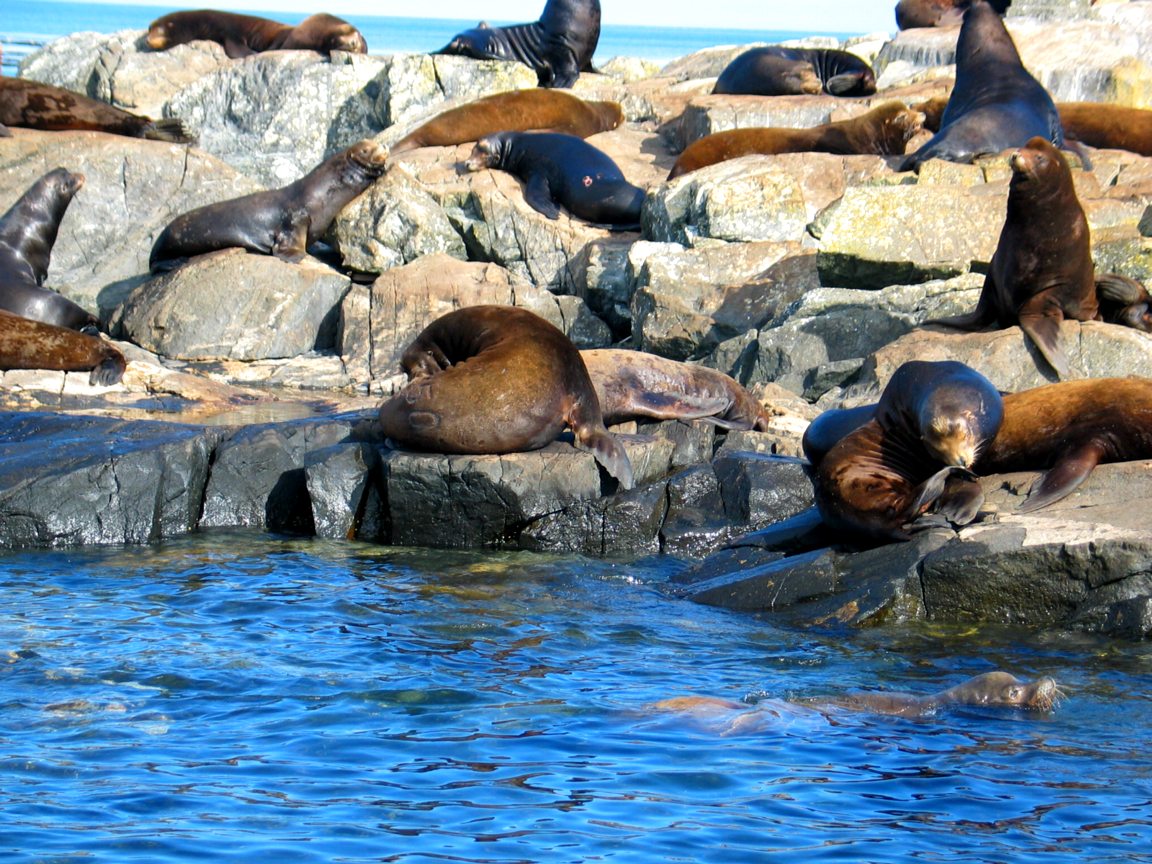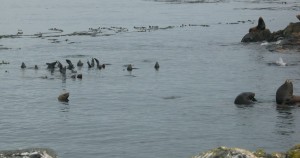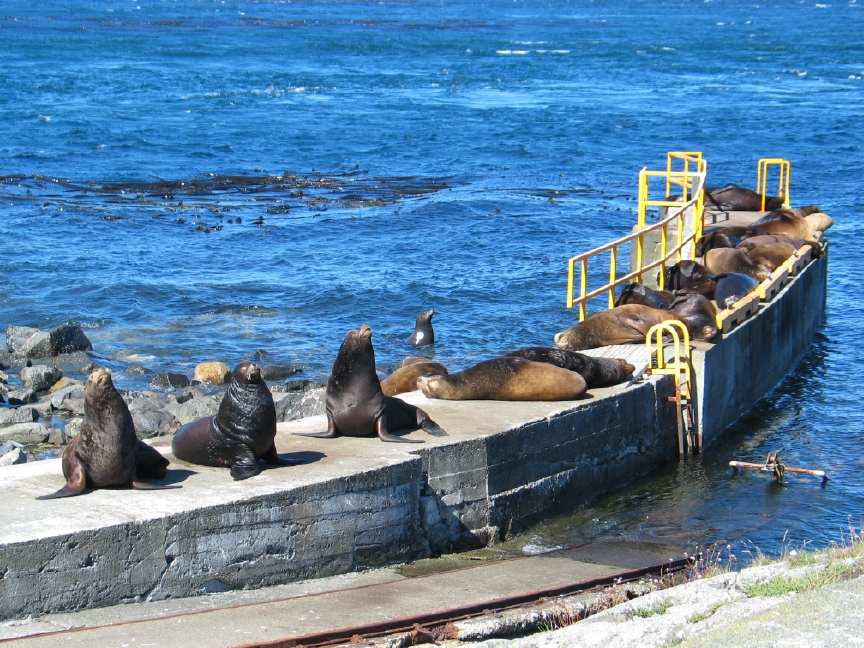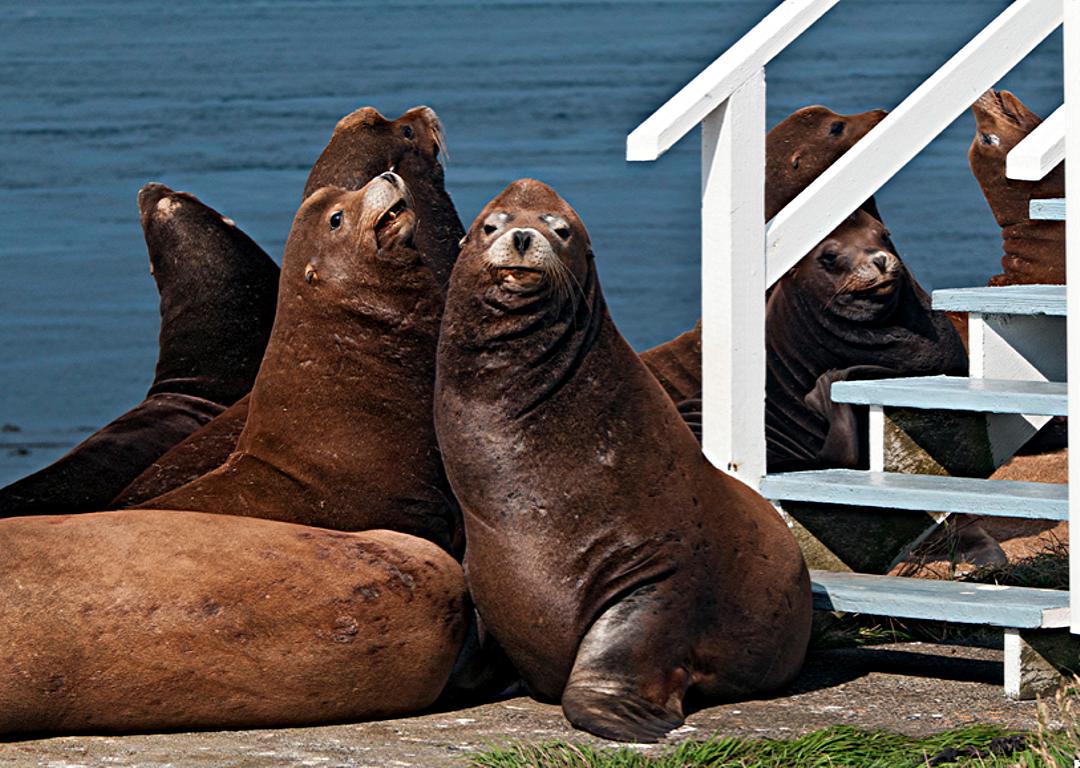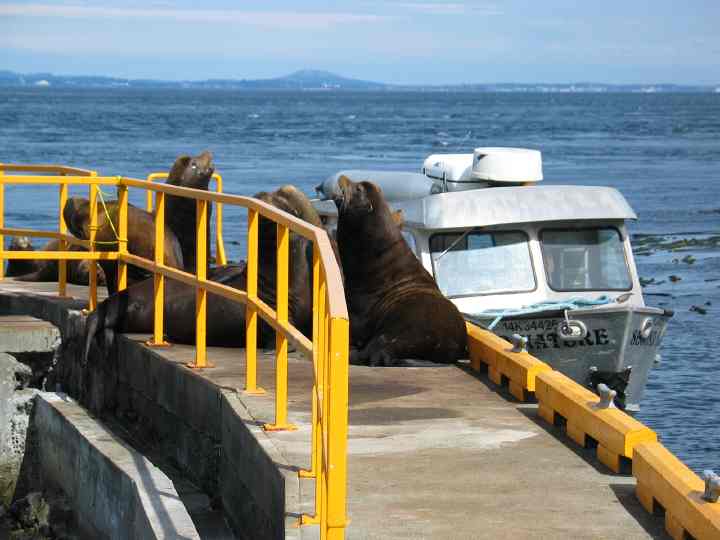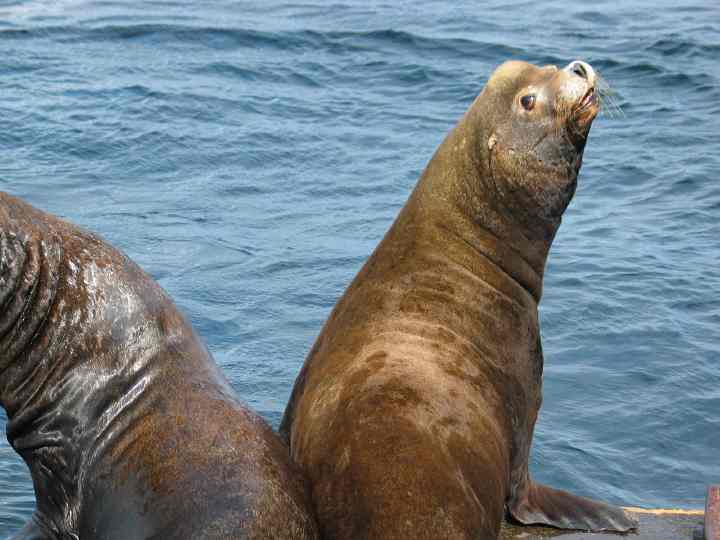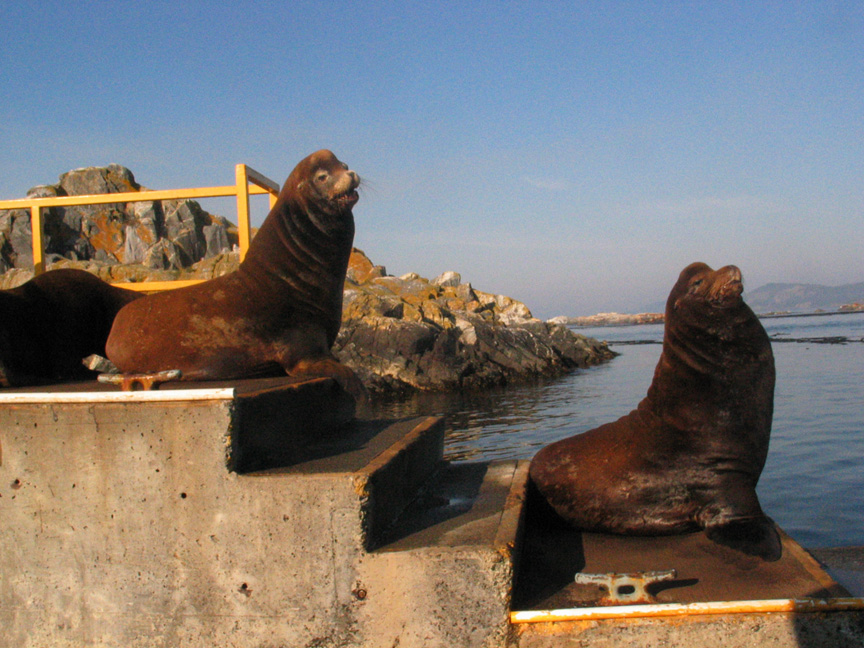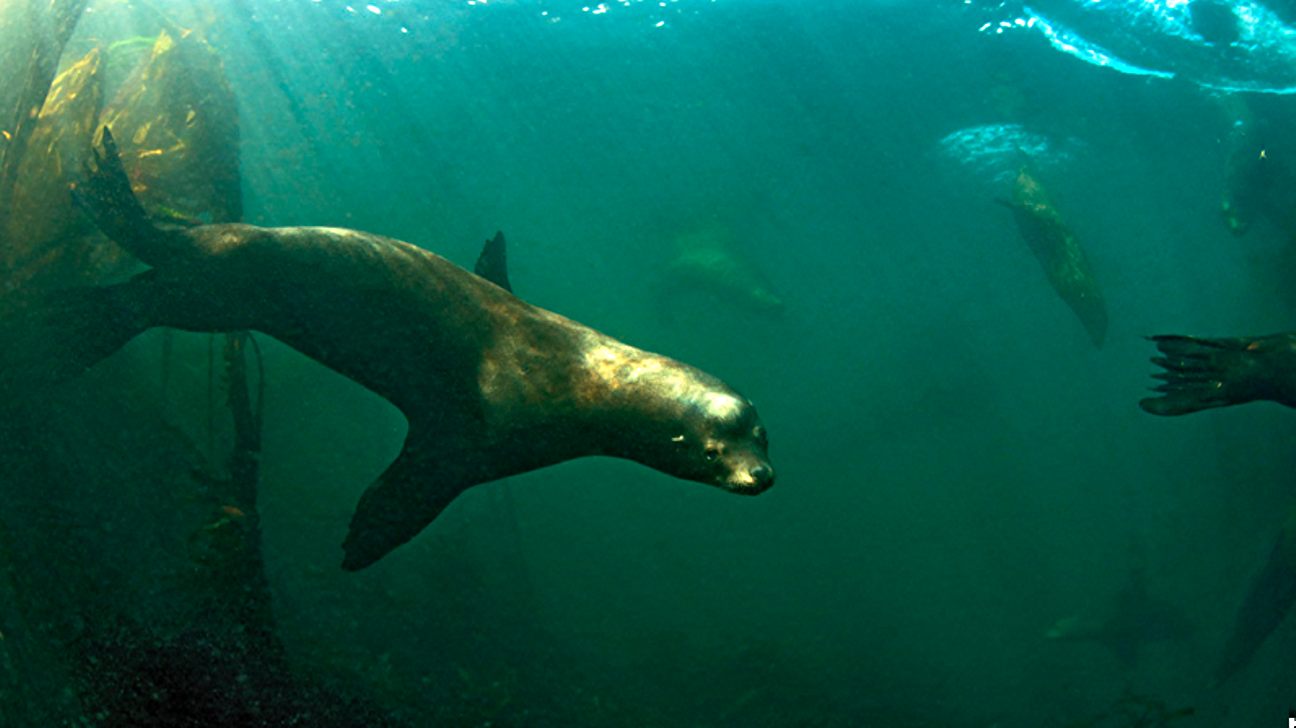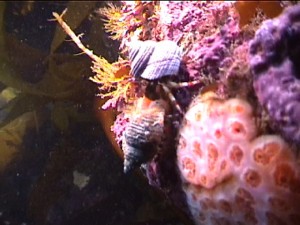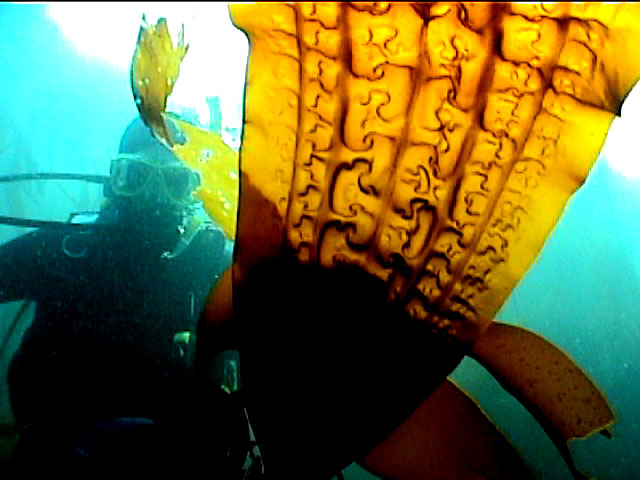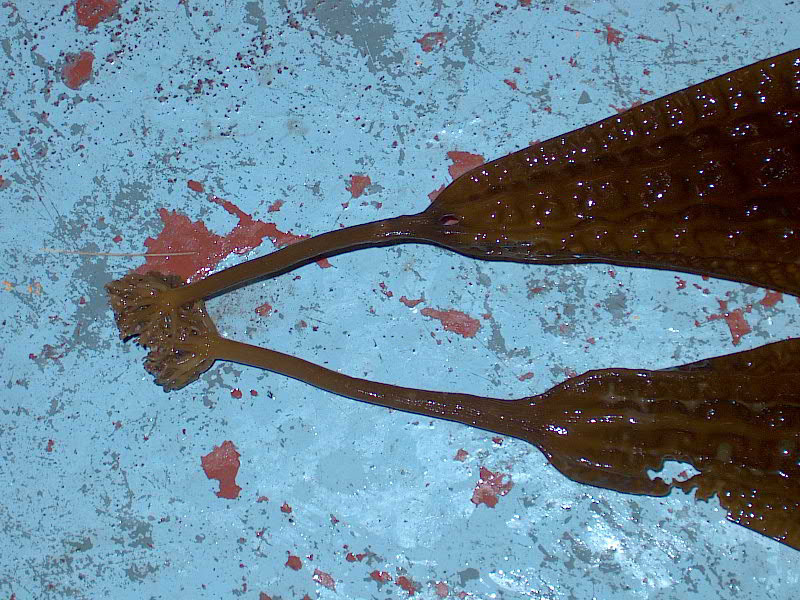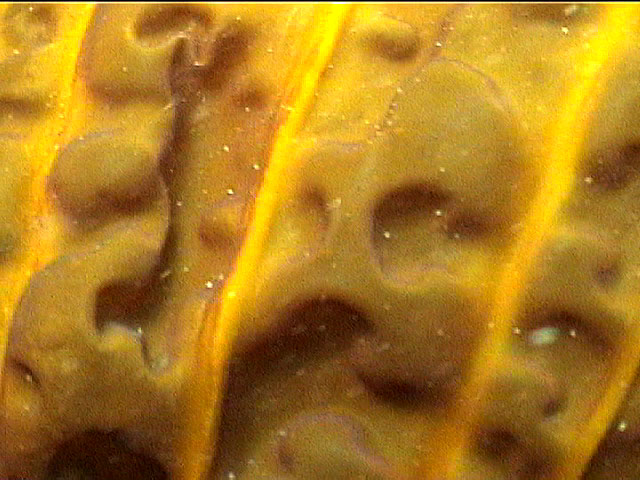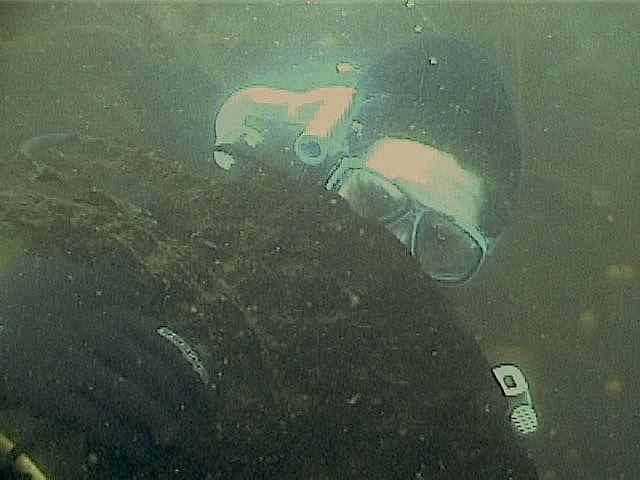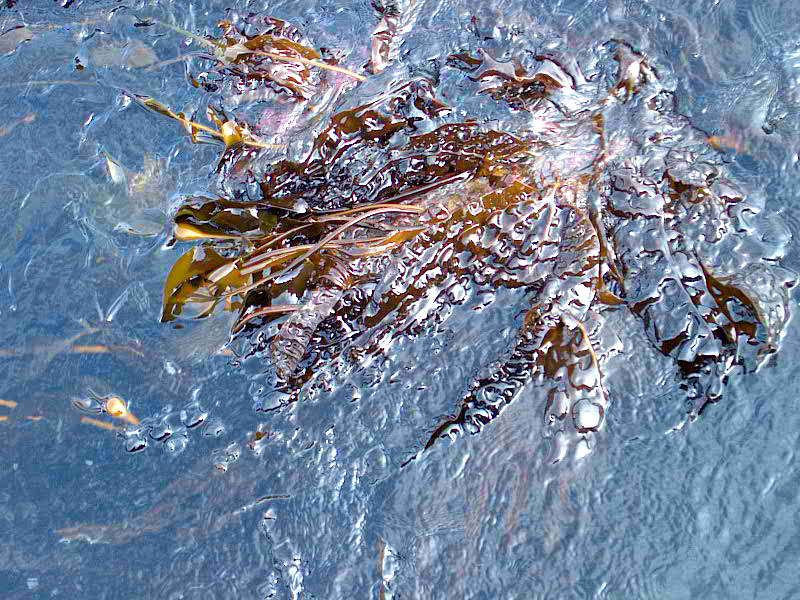Pam Birley has a special skill of capturing the unusual events at Race Rocks. The winter provides her with opportunities to se the Bald Eagles in various moods.
Monthly Archives: December 2002
Oregonia gracilis: Decorator Crab — The Race Rocks Taxonomy
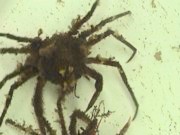 Decorator crabs are common in the intertidal and subtidal areas at Race Rocs. Their habit of attaching bits of algae, or shell on their carapace makes them well camouflaged. They are a small crab, only up to 2-3 cm width in their carapace.
Decorator crabs are common in the intertidal and subtidal areas at Race Rocs. Their habit of attaching bits of algae, or shell on their carapace makes them well camouflaged. They are a small crab, only up to 2-3 cm width in their carapace.
In 1889, William Bateson observed in detail the way that decorator crabs fix materials on their backs. He noted that “[t]he whole proceeding is most human and purposeful”, and that if a Stenorhynchus crab is cleaned, it will “immediately begin to clothe itself again with the same care and precision as before”.[2](Wikipedia)
Domain Eukarya
Kingdom: Animalia
Phylum: Arthropoda
Subphylum: Crustacea
Class: Malacostrata
Order: Decapoda
Family: Majidae
Genus Oregonia
Species gracilis
Common Name: Decorator Crab
| Other Members of the Phylum Arthropoda at Race Rocks |
and Image File |
 The Race Rocks taxonomy is a collaborative venture originally started with the Biology and Environmental Systems students of Lester Pearson College UWC. It now also has contributions added by Faculty, Staff, Volunteers and Observers on the remote control webcams. The Race Rocks taxonomy is a collaborative venture originally started with the Biology and Environmental Systems students of Lester Pearson College UWC. It now also has contributions added by Faculty, Staff, Volunteers and Observers on the remote control webcams.
name 2002 (PC) |
Larus philadelphia: Bonaparte’s gull – The Race Rocks taxonomy
- Bonapartes Gull in Pedder Bay
Bonaparte`s Gull is one of the smallest North American gull. The small size12″-14″( 33 cm) and light buoyant flight of They are reminiscent of terns. Wingspreads range from 24 to 63 in. (0.6-1.6 m).
Summer adults have black heads, grey mantles and white underparts and tail. The wings show white outer primaries with black trailing edges. The bill is slender and black. The legs and the feet are reddish-orange. In winter, the black head becomes white with dark round spot behind the eye. Juveniles show dark ear spot on the head. They have brown on the mantle, scapulars and sides of the breast. The tail is white with a black terminal band. The legs are pinkish. By late September, young birds have moulted into the first winter plumage, characterized by a narrow dark bar on the upper wings, a dark leading edge to the primaries, which together form an “M” across the upper surface of the wings. They lose the juvenile`s brown but retain the terminal band on the tail. In their first summer, they begin to show a dark hood, and the”M” pattern on the wings begins to fade through wear. Bonaparte`s Gull attain adult winter plumage in their second year.
They are escpecially common in late August , September and October when swarms of Krill enter the waters.
Bonaparte`s Gulls are present in Race Rocks as omnivores. They feed on insects, worms, fish, mollusks, crustaceans in Pedder Bay and in the waters from Pedder Bay out to Race Rocks. They nest as isolated pairs or in small colonies, in other parts of British Columbia
Domain Eukarya
Kingdom Animalia
Phylum Chordata
Subphylum Vertebrata
Class Aves
Order Charadiformes
Genus Larus
Species philadelphia
Common Name: Bonaparte`s gull
Websites and references:
http://www.birds.cornell.edu/BOW/BO NGUL/
Peterson Field Guides. Peterson , Roger Tory. “Western Birds”. third edition(1990) Hougthon Mifflin Press: p. 96,102
|
Other Members of the Class Aves at Race Rocks.
|
and Image File |
 The Race Rocks taxonomy is a collaborative venture originally started with the Biology and Environmental Systems students of Lester Pearson College UWC. It now also has contributions added by Faculty, Staff, Volunteers and Observers on the remote control webcams. December 2002- Giulio Esposito PC year 29 The Race Rocks taxonomy is a collaborative venture originally started with the Biology and Environmental Systems students of Lester Pearson College UWC. It now also has contributions added by Faculty, Staff, Volunteers and Observers on the remote control webcams. December 2002- Giulio Esposito PC year 29 |
Boats in The Ecological reserve to Dec 2002
Partial records from the old Race Rocks Log transferred to this log. GF Includes boat section and infractions section from the database,
(16, ‘2002-08-14’, ‘Pleasure’, 0, ‘HUMAN INTERACTION: There were 27 Ecotour boats, 8 pleasure craft and Second Nature through the reserve today.\r\nposted by Carol or Mike S at 7:05 PM\r\n’, ‘Mike’, ’15:33:14′),
(2, ‘2002-08-14’, ‘Pleasure’, 8, ”, ‘Mike’, ’10:52:33′),
(3, ‘2002-08-13’, ‘Pleasure’, 9, ”, ‘Mike’, ’10:55:47′),
(4, ‘2002-08-13’, ‘Eco-Tour’, 33, ”, ‘Mike’, ’10:56:18′),
(5, ‘2002-08-13’, ‘Eco-Tour’, 33, ”, ‘Mike’, ’10:58:47′),
(6, ‘2002-08-12’, ‘Pleasure’, 13, ”, ‘Mike’, ’11:06:32′),
(7, ‘2002-08-12’, ‘Eco-Tour’, 50, ”, ‘Mike’, ’06:46:55′),
(8, ‘2002-08-11’, ‘Pleasure’, 9, ”, ‘Mike’, ’11:13:16′),
(9, ‘2002-08-11’, ‘Eco-Tour’, 6, ”, ‘Mike’, ’11:13:51′),
(10, ‘2002-08-11’, ‘Diving’, 1, ”, ‘Mike’, ’11:14:14′),
(11, ‘2002-08-03’, ‘Pleasure’, 9, ”, ‘Mike’, ’11:20:37′),
(12, ‘2002-08-03’, ‘Eco-Tour’, 21, ”, ‘Mike’, ’11:20:57′),
(13, ‘2002-08-11’, ‘Other’, 1, ‘Chris in Hyaku’, ‘Mike’, ’11:42:45′),
(14, ‘2002-08-09’, ‘Eco-Tour’, 34, ’34 tour boats through the reserve today, many boats toured the reserve early today in the thick fog. With visibility severely limited, many pushed too close to the islands under current regulations. As well, with so many boats and so little visibility, so’, ‘Ryan’, ’11:56:02′),
(15, ‘2002-08-15’, ‘Eco-Tour’, 23, ”, ‘Mike’, ’14:02:16′),
(17, ‘2002-08-16’, ‘Fishing’, 1, ‘3 on board fishing No. ( WN 5065 LN )’, ‘Mike-Carol’, ’15:33:53′),
(18, ‘2002-08-16’, ‘Eco-Tour’, 2, ‘light day’, ‘Mike-Carol’, ’21:27:49′),
(21, ‘2002-08-23’, ‘Eco-Tour’, 25, ”, ‘Mike’, ’22:56:53′),
(22, ‘2002-08-23’, ‘Diving’, 1, ”, ‘Mike’, ’22:57:34′),
(23, ‘2002-08-23’, ‘Pleasure’, 1, ”, ‘Mike’, ’22:57:58′),
(24, ‘2002-08-23’, ‘Other’, 1, ‘Station Boat to Pedder Bay’, ‘Mike’, ’22:58:38′),
(25, ‘2002-08-25’, ‘Pleasure’, 3, ”, ‘Mike’, ’23:06:30′),
(26, ‘2002-08-25’, ‘Eco-Tour’, 28, ”, ‘Mike’, ’23:07:07′),
(27, ‘2002-08-25’, ‘Diving’, 1, ”, ‘Mike’, ’23:07:24′),
(29, ‘2002-08-02’, ‘Eco-Tour’, 6, ”, ‘Carol or Mike’, ’15:46:13′),
(30, ‘2002-08-02’, ‘Pleasure’, 7, ”, ‘Carol or Mike’, ’15:46:41′),
(31, ‘2002-01-03’, ‘Pleasure’, 2, ”, ‘Carol or Mike S’, ’15:56:08′),
(32, ‘2002-08-04’, ‘Eco-Tour’, 53, ”, ‘Carol or Mike’, ’15:51:25′),
(33, ‘2002-03-05’, ‘Pleasure’, 1, ‘1 Pleasure craft through the M.P.A. today.’, ‘Carol or Mike S’, ’15:51:41′),
(34, ‘2002-08-04’, ‘Pleasure’, 13, ”, ‘Carol or Mike’, ’15:51:45′),
(35, ‘2002-01-03’, ‘Diving’, 1, ‘ 1- 4 metre boat with 3 divers between Gr. Race and West Race.\r\n’, ‘Garry’, ’15:52:22′),
(36, ‘2002-03-05’, ‘Other’, 1, ‘Race Rocks boat over to Parry Bay to Bring Garry over to work on the data system.’, ‘Carol or Mike S’, ’15:52:28′),
(37, ‘2002-01-03’, ‘Eco-Tour’, 1, ”, ‘Garry’, ’15:54:01′),
(38, ‘2002-01-04’, ‘Other’, 1, ”, ‘Mike or Carol’, ’15:59:02′),
(39, ‘2001-12-24’, ‘Eco-Tour’, 1, ’11:30 am 1 Whale Watcher Boat’, ‘Carol or Mike S’, ’16:01:36′),
(40, ‘2002-08-08’, ‘Eco-Tour’, 23, ”, ‘Carol or Mike’, ’16:07:20′),
(41, ‘2002-08-08’, ‘Pleasure’, 4, ”, ‘Carol or Mike’, ’16:07:36′),
(42, ‘2002-08-10’, ‘Eco-Tour’, 25, ”, ‘Garry’, ’16:12:51′),
(43, ‘2002-08-10’, ‘Pleasure’, 1, ”, ‘Carol or Mike’, ’16:13:06′),
(44, ‘2002-08-10’, ‘Other’, 1, ‘Marine Mammal Monitor boat in the reserve today. The station boat made a return trip to Pedder Bay and a trip to the Campus in the afternoon to return Ryan back to civilization – Thank you Ryan!\n’, ‘Carol or Mike’, ’16:14:15′),
(45, ‘2002-11-30’, ‘Pleasure’, 2, ”, ‘Mike’, ’14:04:11′),
(46, ‘2002-11-30’, ‘Eco-Tour’, 3, ”, ‘Mike’, ’14:04:34′),
(47, ‘2002-11-30’, ‘Diving’, 1, ‘The Juan de Fuca Warrior made morning dive along the north shore of Gr. Race and an afternoon dive off West Race. Did not observe any interference with the wildlife.’, ‘Mike’, ’14:07:33′),
(48, ‘2002-12-01’, ‘Pleasure’, 2, ”, ‘Mike’, ’14:09:07′),
(49, ‘2002-12-01’, ‘Eco-Tour’, 3, ”, ‘Mike’, ’14:09:39′),
(50, ‘2002-12-15’, ‘Eco-Tour’, 2, ‘with the storm warnings up was surprised to see 2 tour boats come through about 11:30 -both from Springtide.’, ‘Mike’, ’11:23:11′),
‘2002-08-11′, ’18:14:00’, ‘Fishing’, ‘Boat’, ’14K 29105′, ‘Unfortuately there are still sports fishers who have either not familiarized themselves with the fishing regulations or are just ignoring them but today, because the tide was too low to launch the station boat we had to call Chris to come out in the Hyaku’, ‘Mike’, ’11:33:21′),
‘2002-08-09′, ’19:19:00’, ‘Speed’, ‘Boat’, ”, ‘At a quarter to 4 one tour zodiac decided to disregard the no-wake regulation and sped past Great Race, an unfortunate incident not repeated by other tour boats today.\r\n’, ‘Ryan’, ’11:57:19′),
‘2002-08-15′, ’09:20:19’, ‘Landing’, ‘Other’, ”, ‘Coast Guard Helicopter landed near tower leading to a great disturbance of the gulls. Escaping youngsters were attacked by groups of parents . ‘, ‘Mike-Carol’, ’14:14:13′),
‘2002-08-15′, ’15:23:28’, ‘Fishing’, ‘Boat’, ”, ‘hi Garry just looking at precipitation could we get it to read.\r\n”Precipitation Rain ____mm Snow ___cm Total ____mm’, ‘Mike’, ’15:29:15′)
‘2002-08-14’, ‘Pleasure’, 0, ‘HUMAN INTERACTION: There were 27 Ecotour boats, 8 pleasure craft and Second Nature through the reserve today.\r\nposted by Carol or Mike S at 7:05 PM\r\n’, ‘Mike’, ’15:33:14′),
‘2002-08-14’, ‘Pleasure’, 8, ”, ‘Mike’, ’10:52:33′),
‘2002-08-13’, ‘Pleasure’, 9, ”, ‘Mike’, ’10:55:47′),
‘2002-08-13’, ‘Eco-Tour’, 33, ”, ‘Mike’, ’10:56:18′),
‘2002-08-13’, ‘Eco-Tour’, 33, ”, ‘Mike’, ’10:58:47′),
‘2002-08-12’, ‘Pleasure’, 13, ”, ‘Mike’, ’11:06:32′),
‘2002-08-12’, ‘Eco-Tour’, 50, ”, ‘Mike’, ’06:46:55′),
‘2002-08-11’, ‘Pleasure’, 9, ”, ‘Mike’, ’11:13:16′),
‘2002-08-11’, ‘Eco-Tour’, 6, ”, ‘Mike’, ’11:13:51′),
‘2002-08-11’, ‘Diving’, 1, ”, ‘Mike’, ’11:14:14′),
‘2002-08-03’, ‘Pleasure’, 9, ”, ‘Mike’, ’11:20:37′),(16, ‘2002-08-14’, ‘Pleasure’, 0, ‘HUMAN INTERACTION: There were 27 Ecotour boats, 8 pleasure craft and Second Nature through the reserve today.\r\nposted by Carol or Mike S at 7:05 PM\r\n’, ‘Mike’, ’15:33:14′),
‘2002-08-14’, ‘Pleasure’, 8, ”, ‘Mike’, ’10:52:33′),
‘2002-08-03’, ‘Eco-Tour’, 21, ”, ‘Mike’, ’11:20:57′),
‘2002-08-11’, ‘Other’, 1, ‘Chris in Hyaku’, ‘Mike’, ’11:42:45′),
‘2002-08-09’, ‘Eco-Tour’, 34, ’34 tour boats through the reserve today, many boats toured the reserve early today in the thick fog. With visibility severely limited, many pushed too close to the islands under current regulations. As well, with so many boats and so little visibility, so’, ‘Ryan’, ’11:56:02′),(1, ‘2002-08-11′, ’18:14:00’, ‘Fishing’, ‘Boat’, ’14K 29105′, ‘Unfortuately there are still sports fishers who have either not familiarized themselves with the fishing regulations or are just ignoring them but today, because the tide was too low to launch the station boat we had to call Chris to come out in the Hyaku’, ‘Mike’, ’11:33:21′),
‘2002-08-09′, ’19:19:00’, ‘Speed’, ‘Boat’, ”, ‘At a quarter to 4 one tour zodiac decided to disregard the no-wake regulation and sped past Great Race, an unfortunate incident not repeated by other tour boats today.\r\n’, ‘Ryan’, ’11:57:19′),
‘2002-08-15′, ’09:20:19’, ‘Landing’, ‘Other’, ”, ‘Coast Guard Helicopter landed near tower leading to a great disturbance of the gulls. Escaping youngsters were attacked by groups of parents . ‘, ‘Mike-Carol’, ’14:14:13′),
‘2002-08-15′, ’15:23:28’, ‘Fishing’, ‘Boat’, ”, ‘hi Garry just looking at precipitation could we get it to read.\r\n”Precipitation Rain ____mm Snow ___cm Total ____mm’, ‘Mike’, ’15:29:15′),
‘2002-08-15’, ‘Eco-Tour’, 23, ”, ‘Mike’, ’14:02:16′),
‘2002-08-16’, ‘Fishing’, 1, ‘3 on board fishing No. ( WN 5065 LN )’, ‘Mike-Carol’, ’15:33:53′),
‘2002-08-16’, ‘Eco-Tour’, 2, ‘light day’, ‘Mike-Carol’, ’21:27:49′),
‘2002-08-23’, ‘Eco-Tour’, 25, ”, ‘Mike’, ’22:56:53′),
‘2002-08-23’, ‘Diving’, 1, ”, ‘Mike’, ’22:57:34′),
2002-08-23′, ‘Pleasure’, 1, ”, ‘Mike’, ’22:57:58′),
‘2002-08-23’, ‘Other’, 1, ‘Station Boat to Pedder Bay’, ‘Mike’, ’22:58:38′),
‘2002-08-25’, ‘Pleasure’, 3, ”, ‘Mike’, ’23:06:30′),
‘2002-08-25’, ‘Eco-Tour’, 28, ”, ‘Mike’, ’23:07:07′),
‘2002-08-25’, ‘Diving’, 1, ”, ‘Mike’, ’23:07:24′),
‘2002-08-02’, ‘Eco-Tour’, 6, ”, ‘Carol or Mike’, ’15:46:13′),
‘2002-08-02’, ‘Pleasure’, 7, ”, ‘Carol or Mike’, ’15:46:41′),
‘2002-01-03’, ‘Pleasure’, 2, ”, ‘Carol or Mike S’, ’15:56:08′),
‘2002-08-04’, ‘Eco-Tour’, 53, ”, ‘Carol or Mike’, ’15:51:25′),
‘2002-03-05’, ‘Pleasure’, 1, ‘1 Pleasure craft through the M.P.A. today.’, ‘Carol or Mike S’, ’15:51:41′),
‘2002-08-04’, ‘Pleasure’, 13, ”, ‘Carol or Mike’, ’15:51:45′),
‘2002-01-03’, ‘Diving’, 1, ‘ 1- 4 metre boat with 3 divers between Gr. Race and West Race.\r\n’, ‘Garry’, ’15:52:22′),
‘2002-03-05’, ‘Other’, 1, ‘Race Rocks boat over to Parry Bay to Bring Garry over to work on the data system.’, ‘Carol or Mike S’, ’15:52:28′),
‘2002-01-03’, ‘Eco-Tour’, 1, ”, ‘Garry’, ’15:54:01′),
‘2002-01-04’, ‘Other’, 1, ”, ‘Mike or Carol’, ’15:59:02′),
‘2001-12-24’, ‘Eco-Tour’, 1, ’11:30 am 1 Whale Watcher Boat’, ‘Carol or Mike S’, ’16:01:36′),
‘2002-08-08’, ‘Eco-Tour’, 23, ”, ‘Carol or Mike’, ’16:07:20′),
‘2002-08-08’, ‘Pleasure’, 4, ”, ‘Carol or Mike’, ’16:07:36′),
‘2002-08-10’, ‘Eco-Tour’, 25, ”, ‘Garry’, ’16:12:51′),
‘2002-08-10’, ‘Pleasure’, 1, ”, ‘Carol or Mike’, ’16:13:06′),
‘2002-08-10’, ‘Other’, 1, ‘Marine Mammal Monitor boat in the reserve today. The station boat made a return trip to Pedder Bay and a trip to the Campus in the afternoon to return Ryan back to civilization – Thank you Ryan!\n’, ‘Carol or Mike’, ’16:14:15′),
‘2002-11-30’, ‘Pleasure’, 2, ”, ‘Mike’, ’14:04:11′),
‘2002-11-30’, ‘Eco-Tour’, 3, ”, ‘Mike’, ’14:04:34′),
‘2002-11-30’, ‘Diving’, 1, ‘The Juan de Fuca Warrior made morning dive along the north shore of Gr. Race and an afternoon dive off West Race. Did not observe any interference with the wildlife.’, ‘Mike’, ’14:07:33′),
‘2002-12-01’, ‘Pleasure’, 2, ”, ‘Mike’, ’14:09:07′),
‘2002-12-01’, ‘Eco-Tour’, 3, ”, ‘Mike’, ’14:09:39′),
‘2002-12-15’, ‘Eco-Tour’, 2, ‘with the storm warnings up was surprised to see 2 tour boats come through about 11:30 -both from Springtide.’, ‘Mike’, ’11:23:11′),
‘2002-08-26’, ‘Pleasure’, 4, ”, ‘Carol or Mike S’, ’15:56:52′),
‘2002-08-26’, ‘Eco-Tour’, 27, ”, ‘Carol or Mike S’, ’15:57:07′),
Aphriza virgata: Surfbird–The Race Rocks Taxonomy
|
|||||||||||||||||||||||||
- Surfbird in breeding plumage Photo by Mike Robinson, April 2013
- Surfbird eating sea lettuce Photo by Mike Robinson, April 2013
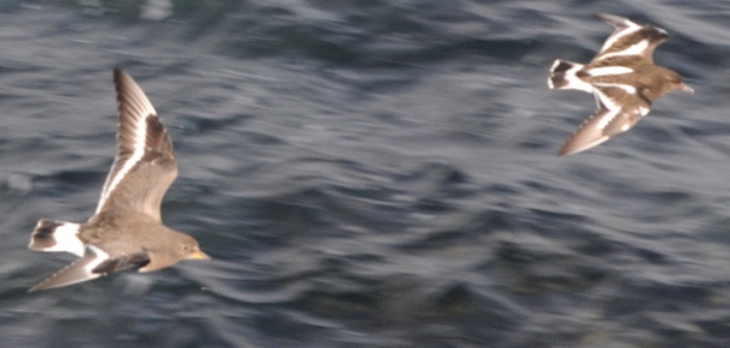
Below, in this photo by Barry Herring we can contrast the back coloration in flight of the Surfbird. on the left and the Black Turnstone on the right.
Return to the Race Rocks taxonomy Index
| This file is provided as part of a collaborative effort by the students, faculty, s staff and volunteers of Lester B. Pearson College | Dec. 2002 | Claude Bajada (PC Yr 29) Malta |
Zalophus californianus: The california sea lion
DESCRIPTION:
California sea lions are known for their intelligence, playfulness, and noisy barking. Their color tends toward chocolate brown, although females are often a lighter golden brown. Males may reach 1,000 lbs. (more often 850 lbs.or 390 kg) and 7 feet (2.1 m) in length. Females grow to 220 lbs. (110 kg) and up to 6 feet (1.8 m) in length. They have a “dog-like” face, and around five years of age, males develop a bony bump on top of their skull called a sagittal crest. The top of a male’s head often gets lighter with age. These members of the Otariid, or walking seal, family have external ear flaps and are equipped with large flippers which they use to “walk” on land. The trained “seals” in zoos and aquaria are usually California sea lions.
In 1970 , Trevor Anderson reported to David Hancock for the Journal article “California Sea Lion as a Regular Winter Visitant off the British Columbia Coast” that ” California Sea Lions had hauled out on rocks near the light every winter since 1966…. and a peak of population of 30 was reached in February, 1969.”
It is clear that the population of these animals has risen considerably over the years, and by 2007, up to 300 may haul out in the fall of the year. ( 500 in 2015)
They tend to move out of the dock area with the winter storms which bring swells from the North East. They also haul out mixed in with the Northern or Steller’s sealion.
- Compare the Northern Sealion on the left with the california sea lion beside . Mt Baker in the background
- In late August, the California Sea Lions arrive back in large numbers from the outer coast . By the end of October, they often number over 1000.
RANGE/HABITAT:
California sea lions are found from Vancouver Island, British Columbia, to the southern tip of Baja California in Mexico. They breed mainly on offshore islands from southern California’s Channel Islands south to Mexico, although a few pups have been born on Año Nuevo and the Farallon Islands in central California. There is a distinct population of California sea lions at the Galapagos Islands.
We keep track of the branded sealions at Race Rocks: two links: https://www.racerocks.ca/race-rocks-animals-plants/marine-mammal-tracking/
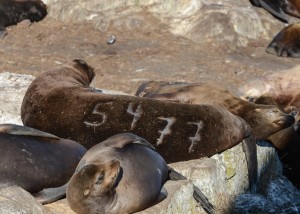 Records of Sea Lion brands: You can see the Ecoguardian’s notes and images of the branded sea lions in the log for 2011-2013 etc. here.
Records of Sea Lion brands: You can see the Ecoguardian’s notes and images of the branded sea lions in the log for 2011-2013 etc. here.
Previous photos and observations of tracking devices prior to 2011 can be seen in this linked file:
BREEDING
Sea lions do not pup at Race Rocks, it is strictly a winter haulout colony. Most pups are born on the outer coast to the South in June or July and weigh 13-20 lbs. (6-9 kg). They nurse for at least 5-6 months and sometimes over a year. Mothers recognize pups on crowded rookeries through smell, sight, and vocalizations. Pups also learn to recognize the vocalizations of their mothers. Breeding takes place a few weeks after birth. Males patrol territories and bark almost continuously during the breeding season. Gestation lasts about 50 weeks and lactation 5 to 12 months. The longevity is estimated to be around 17 years.
SUBSPECIES
Three subspecies are recognized: Zalophus californianus californianus (Lesson, 1828), Zalophus californianus wollebaeki (Sivertsen, 1953) and Zalophus californianus japonicus (Peters, 1866), each living in a clearly separate range. According to Rice (1998), the differences between these types justifies classification as separate species: Zalophus californianus, Zalophus wollebaeki and Zalophus japonicus
- Teeth of California Sea Lion: Photos by Ryan Murphy
- Rear flippers,doral and ventral sides.
- Scrotum of Zalophus californianus
- The sun had just come up when Ryan snapped this picture of the sea lions breath. RM photo
- Injury probably from boat propellors. See more of human impacts on sea lions here
- Looks like a pose for this californa sea lion. R.Murphy photo
- Wet fur on the stomach, dry on back, note color contrast.
- 2 sea lions with brands photos by G. Fletcher
 See this link to several archived videos of marine mammals. In particular note the effect of DND blasting on the colonies.
See this link to several archived videos of marine mammals. In particular note the effect of DND blasting on the colonies.
FEEDING HABITS
California sea lions are opportunistic feeders and eat such things as squid, octopus, herring, rockfish, mackerel, anchovy and whiting. The California sea lion competes with the Northern Sea Lion Eumetopias jubata for habitat and food.
NOTES
California sea lions are very social animals, and groups often rest closely packed together at favored haul-out sites on land, or float together on the ocean’s surface in “rafts.” They are sometimes seen porpoising, or jumping out of the water, presumably to speed up their swimming. Sea lions have also been seen “surfing” breaking waves.
The males are probably the most vocal of all mammals, and let out a loud incessant honking bark to protect over their territories. They are faithful to their territories, and to their harems of up to 15 females. Sea Lions swim up to 25mph which makes them one of the fastest aquatic carnivores.
Sea lions are known to damage fishing gear and steal or destroy fish in the nets. As a result a lot of California sea lions drown in nets and they are frequently shot at by commercial fishers. September, 2003 : This past few months we have seen three California and Northern Sea lions with fishing flashers hanging from their mouths. These animals pursue fishing lures , probably especially when live bait is used. They swallow the bait, and take down the meter plus length of leader line before the flasher comes to their mouth. The individuals will be seen for several days trailing these flashers. It is not known whether they eventually shed the flasher or whether this leads to an untimely death. Although they can pick up a flasher in waters at some distance from their haulouts, it certainly makes sense to restrict fishing activity when marine mammals are in the vicinity of a fishing vessel. This video shows a sea lion with a flasher in his mouth.
Sea lions are preyed upon by killer whales. Sea lions are known to have such diseases as pneumonia, caused by a parasitic lungworm, and a bacterial infection called leptospirosis, which affects their livers and kidneys.
Other problems for California sealions involve humans. Sea lions have been found illegally shot and also caught in drift or gill nets and other marine debris. However, their population is growing steadily, and California sea lions can be seen in many coastal spots.
At Race Rocks they can become a problem in the fall when they arrive in large numbers. We have to put up electric fencing to keep them from damaging the infrastructure on the island as they will crush pipes and instruments.
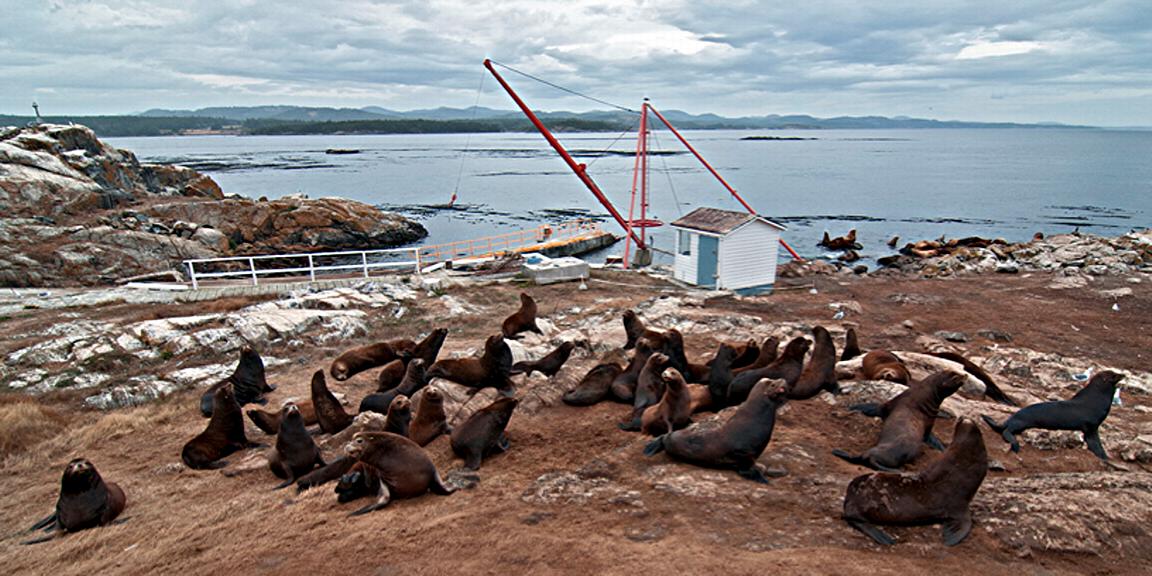
In the fall of 2011, the California sea lions were especially attracted up near the house in mid September . They all departed when an earthquake struck the north end of Vancouver island.
- Sept. 2007. California sea lions return to the docks as soon as he boat leaves.
- California sea lions at the stairs to the main residence.
- While boat occupants are ashore for a few hours the lions regain their spot on the dock.
- Reluctant to move from the docks, Sept 15, 2005
- Won’t even move as the boat docks.
The Californian Sea lion was once killed in great numbers for their blubber which could be made into oil, and the rest would be made into dog food. Today the seal lion is protected by international treaty which has led to a positive shift in their populations.
Unusual Events:
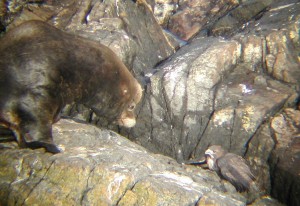 This unusual event involving a red-tailed hawk and a sea lion was observed in October 2003.
This unusual event involving a red-tailed hawk and a sea lion was observed in October 2003.
INJURIES:
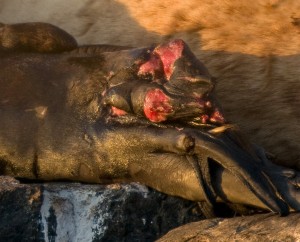 Sea lions bear the brunt of many actions by humans, many which could be avoided with more caution in driving boats through congregations of the mammals.
Sea lions bear the brunt of many actions by humans, many which could be avoided with more caution in driving boats through congregations of the mammals.
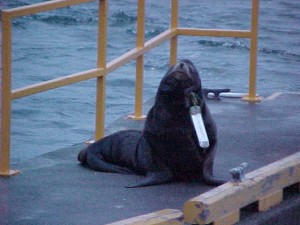 Fishers should bear some responsibility for the many instances of fishing flashers attached to hooks inside.
Fishers should bear some responsibility for the many instances of fishing flashers attached to hooks inside.
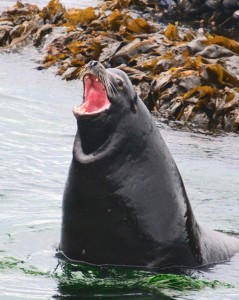 When the sea lions are present in great numbers, we are always seeing individuals with entanglements, usually in the plastic hoops that fishers use for net bundles, Posts at this tag show many examples of injuries and entanglements.
When the sea lions are present in great numbers, we are always seeing individuals with entanglements, usually in the plastic hoops that fishers use for net bundles, Posts at this tag show many examples of injuries and entanglements.
Domain Eukarya
Kingdom Animalia
Phylum Chordata
Class Mammalia
Order Pinnipedia
Family Otariidae
Genus Zalophus
Species californianus
Common Name: California Sea Lion
Other Members of the Class Mammalia at Race Rocks.
Pagurus hirsuitiusculus: hairy hermit crab–The Race Rocks Taxonomy
This video shows the two species, the Hairy hermit crab Pagurus hirsuitiusculus and the sponge Suberites in a commensal biotic association.
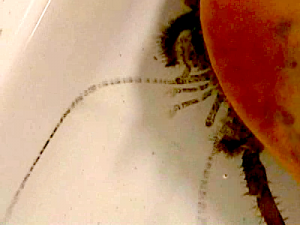
A distinguishing feature of the hairy hermit crab is te banded antennae shown in this image from the video
The specimens studied were collected at Race Rocks in November of 2002. They were unique specimens because of their choice of home. Usually hermit crabs use the shells of snails that have died then discard them as they grow larger in place of a bigger shell. However, these Hairy Hermit Crabs had decided to become the hermit crabs of Hermit Crab Sponges.
Hermit Crab Sponges, Suberites.spp are sponges that attach themselves to a mobile animal who has a solid exoskeleton, usually a snail or crab. In the hermit crab’s case, the sponge begins to grow on their adopted home by first thinly encrusting the shells. As the sponge grows, it begins to cover the shell and can surround it completely, sometimes making locomotion difficult for the crab. Once the sponge has buried the shell inside itself, the hermit crab leaves its shell to occupy a chamber in the sponge it had hollowed out.
CLASSIFICATION:
Domain: Eukarya
Kingdom: Animalia
Phylum: Arthropoda
Class: Crustacea
Order: Decapoda
Superfamily: Paguridea
Family: Paguridea
Genus: Pagurus
Species: hirsuitiusculus
Pagurus hirsuitiusculus
Common Name: Hairy Hermit Crab
Other Members of the Phylum Arthropoda at Race Rocks.
and Image File |
 The Race Rocks taxonomy is a collaborative venture originally started with the Biology and Environmental Systems students of Lester Pearson College UWC. It now also has contributions added by Faculty, Staff, Volunteers and Observers on the remote control webcams. The Race Rocks taxonomy is a collaborative venture originally started with the Biology and Environmental Systems students of Lester Pearson College UWC. It now also has contributions added by Faculty, Staff, Volunteers and Observers on the remote control webcams. |
Suberites suberea: Hermit Crab Sponge–The Race Rocks Taxonomy
Suberites suberea is also known as Suberites ficus .This sponge begins its life by attaching to a mollusc shell. As it grows, it overtakes the shell and eventually dissolves it. A hermit crab (Pagurus sp.) is usually found in the cavity of the sponge, but the sponge is usually quite larger than the crab itself. The sponge is hard and rubbery in texture, and is dark orange in colour. It is Found all around the intertidal and shallow subtidal areas of Race Rocks.
| Domain | Eukarya |
| Kingdom | Animalia |
| Phylum | Porifera |
| Class | Demospongiae |
| Order | Hadromeridia |
| Family | Suberitidae |
| Genus | Suberites |
| Species | suberea |
| Common Name: | Hermit Crab Sponge |
This file is provided as part of a collaborative effort by the students of Lester B. Pearson College Dec. 2002 Jana Morehouse Link to other sponge specimens from Race Rocks Link to the Race Rocks Taxonomy and Image gallery index
| This file is provided as part of a collaborative effort by the students, faculty, staff and volunteers of Lester B. Pearson College | Dec. 2002 | Jana Morehouse |
Costaria costata: five- rib kelp–The Race Rocks Taxonomy
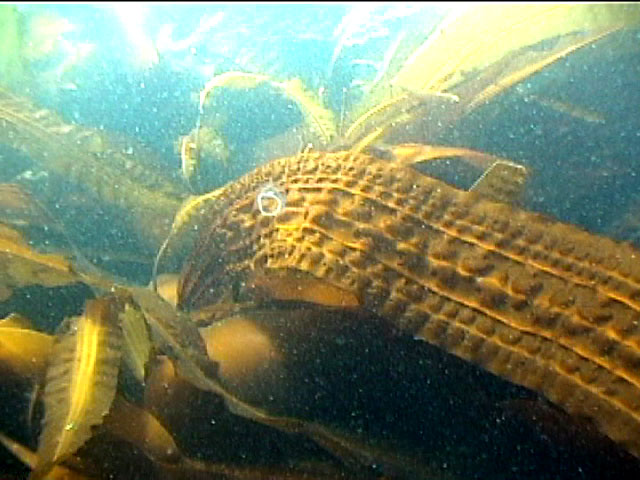 Costaria ( latin= rib) is a brown handsome kelp often growing with Laminaria sp.. It is found around the Race Rocks shallow sub-tidal area. Costaria‘s blade is up to 2 m long and it has five midribs running its length, three on one side and two on the other. The midribs are concave on the bottom. The blade tissue, sitting between the ribs, is elaborately contorted into a system of ridges and valleys. Costaria costata is an annual. distributed from Alaska to southern California in the low intertidal and upper sub-tidal regions.This brown algae displays a range of shapes, reflecting the degree of wave exposure it encounters. In wave-exposed sites the plants are narrow and thick. their stipes are ridged and a series of regular perforations run the length of the blade. Wave-sheltered plants are broad and thin, having smooth stipes and no perforations. Transplant studies have shown these differences in morphology to be environmentally induced. For example, a plant moved from a wave-exposed locality to a sheltered are will produce new blade tissue characteristics of wave-sheltered plants. this morphological response to environmental differences is called phenotypic plasticity. In sheltered waters the blade is long and narrow while in surf waters it grows in a big, wrinkled egg shape.
Costaria ( latin= rib) is a brown handsome kelp often growing with Laminaria sp.. It is found around the Race Rocks shallow sub-tidal area. Costaria‘s blade is up to 2 m long and it has five midribs running its length, three on one side and two on the other. The midribs are concave on the bottom. The blade tissue, sitting between the ribs, is elaborately contorted into a system of ridges and valleys. Costaria costata is an annual. distributed from Alaska to southern California in the low intertidal and upper sub-tidal regions.This brown algae displays a range of shapes, reflecting the degree of wave exposure it encounters. In wave-exposed sites the plants are narrow and thick. their stipes are ridged and a series of regular perforations run the length of the blade. Wave-sheltered plants are broad and thin, having smooth stipes and no perforations. Transplant studies have shown these differences in morphology to be environmentally induced. For example, a plant moved from a wave-exposed locality to a sheltered are will produce new blade tissue characteristics of wave-sheltered plants. this morphological response to environmental differences is called phenotypic plasticity. In sheltered waters the blade is long and narrow while in surf waters it grows in a big, wrinkled egg shape.
- The transparency of the blade
- Holdfasts in algae are analogous to roots in terrestrial plants.
- Blades in algae are analogous to leaves in terrestrial plants
- The photographer of these pictures, Ryan Murphy , behind a Costaria blade.
Classification
Domain: Eyukarya
Kingdom: Protochtista
Division: Phaeophyta
Class: Phaeophyaceae
Order: Laminariales
Family: Laminariaceae
Genus: Costaria
Species: costata
Common Name: five- rib kelp
References:
Druehl,Luis. “Pacific Seaweeds”,Harbour, Canada, 2000
Other Phaeophytes or Brown Algae at Race Rocks
 The Race Rocks taxonomy is a collaborative venture originally started with the Biology and Environmental Systems students of Lester Pearson College UWC. It now also has contributions added by Faculty, Staff, Volunteers and Observers on the remote control webcams. Jana Morehouse PC 2002 The Race Rocks taxonomy is a collaborative venture originally started with the Biology and Environmental Systems students of Lester Pearson College UWC. It now also has contributions added by Faculty, Staff, Volunteers and Observers on the remote control webcams. Jana Morehouse PC 2002 |
Eagles Congregate in Winter at Race Rocks
In January, on a planned dive off West Race Rocks, the divers had to divert to another location because of a large number of eagles on the island. They shot this clip as they went by the island. Carol Slater had counted 43 on the Rocks earlier in the day. This is typical of their peak in numbers every January. The brown juveniles and the white headed adults number fairly equally.

